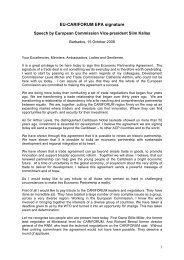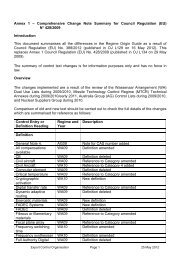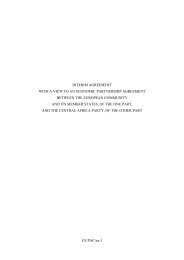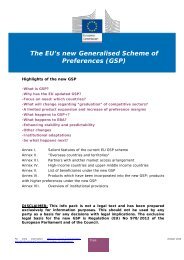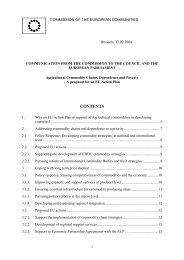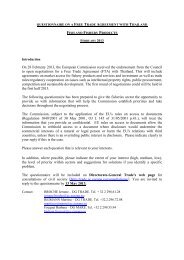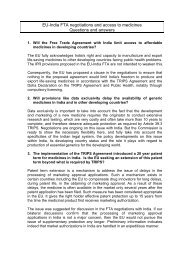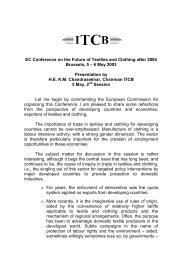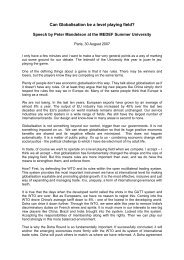Report on the Implementation of the derogation to ... - Trade Websites
Report on the Implementation of the derogation to ... - Trade Websites
Report on the Implementation of the derogation to ... - Trade Websites
Create successful ePaper yourself
Turn your PDF publications into a flip-book with our unique Google optimized e-Paper software.
Final <str<strong>on</strong>g>Report</str<strong>on</strong>g><br />
RoO Derogati<strong>on</strong> under <strong>the</strong> PACP-IEPA<br />
6.3 Major Suppliers <strong>of</strong> <strong>the</strong> EU Canned Tuna Market<br />
There are two sets <strong>of</strong> suppliers <strong>of</strong> canned tuna <strong>to</strong> EU markets: EU-based producers (including intra-<br />
EU trade) and third countries (i.e. extra-EU imports). Table 6.3 details <strong>the</strong> split between <strong>the</strong>se two<br />
sources over <strong>the</strong> period 2000-08. Domestic EU producti<strong>on</strong> data are <strong>on</strong>ly available via <strong>the</strong> FAO <strong>to</strong><br />
2008, 257 but note that in 2009 and 2010 <strong>the</strong> extra-EU import market declined in volume (see below).<br />
Table 6.3<br />
EU market volume – domestic producti<strong>on</strong> vs. extra-EU imports (in t<strong>on</strong>nes unless<br />
o<strong>the</strong>rwise specified)<br />
2000 2002 2004 2006 2008<br />
Extra-EU import 289,421 350,691 376,998 422,590 424,148<br />
EU producti<strong>on</strong> 345,974 394,756 360,689 324,500 370,471<br />
Total EU market volume 635,395 745,447 737,687 747,090 794,619<br />
Extra-EU import as % <strong>to</strong>tal 46% 47% 51% 57% 53%<br />
EU producti<strong>on</strong> as % <strong>to</strong>tal 54% 53% 49% 43% 47%<br />
Sources: Fish StatJ for EU producti<strong>on</strong> and EuroStat for Extra-EU imports 2011.<br />
6.4 Intra-EU<br />
The producti<strong>on</strong> <strong>of</strong> canned tuna and related ‘ambient’ 258 (or ‘shelf-stable’) tuna products within <strong>the</strong><br />
EU is dependent up<strong>on</strong> tariff protecti<strong>on</strong> against relatively low cost imports. The EU MFN tariff <strong>of</strong> 24%<br />
<strong>on</strong> canned tuna has been very successful in supporting processors, especially in Spain, which<br />
over<strong>to</strong>ok Italy in 1993 <strong>on</strong>wards <strong>to</strong> be <strong>the</strong> leading EU-based producer <strong>of</strong> canned tuna (see Figure 6.4).<br />
Over <strong>the</strong> last ten-year period for which data are available (1999-2008), Spain accounted for 65.1% <strong>of</strong><br />
<strong>to</strong>tal EU producti<strong>on</strong>, rising from a 60% share in 1999 <strong>to</strong> 72% in 2008. Italy declined from 22% <strong>to</strong> 15%<br />
over <strong>the</strong> same period, as did France, from 13% <strong>to</strong> 10%. Portugal’s share remained relatively stable at<br />
5% and 4%.<br />
Spain hit a record high <strong>of</strong> canned tuna producti<strong>on</strong> in 2008 at 267,280 mt and has been <strong>the</strong> sec<strong>on</strong>d<br />
largest producer <strong>of</strong> canned tuna in <strong>the</strong> world since 2004 when it over<strong>to</strong>ok <strong>the</strong> United States.<br />
259 As<br />
we have seen, <strong>the</strong> import <strong>of</strong> tuna loins is a major comp<strong>on</strong>ent in <strong>the</strong> producti<strong>on</strong> strategies <strong>of</strong> EUbased<br />
firms due <strong>to</strong> relatively high labour costs. It would, however, be <strong>to</strong>o simplistic <strong>to</strong> assume that<br />
Spanish processors will necessarily follow <strong>the</strong> tendency in France and Italy where loins are <strong>the</strong><br />
dominant input in<strong>to</strong> <strong>the</strong> producti<strong>on</strong> process. This is because, in Spain at least, <strong>the</strong> labour process is<br />
competitive (albeit behind tariff and n<strong>on</strong>-tariff barriers) when butchering large sized whole round<br />
fish (e.g. yellowfin over 10kg). Labour productivity – as measured by high recovery rates – is higher<br />
when butchering larger sized fish (<strong>the</strong> average recovery rate for a large yellowfin is 48.5%, but it can<br />
reportedly go up <strong>to</strong> 51%, whereas for skipjack it ranges from 37-40%). 260 In short, for some Spanish<br />
processors, an optimum producti<strong>on</strong> strategy (i.e. <strong>the</strong> balance between labour time/cost and fish<br />
yield) is <strong>to</strong> fully process big yellowfin and import skipjack loins. This supply is supported by <strong>the</strong><br />
Spanish distant water tuna fleet being <strong>the</strong> main supplier <strong>of</strong> raw tuna <strong>to</strong> <strong>the</strong> Spanish canning industry.<br />
257 ANFACO estimates that its members produce around 350,000 mt <strong>of</strong> canned seafood per annum. Around<br />
70% (or 245,000 mt) <strong>of</strong> ANFACO members’ producti<strong>on</strong> is canned tuna. FIS 2011.<br />
258 Such as tuna packed in glass jars or plastic pots.<br />
259 Globefish 2010: 72-3. Thailand first emerged as <strong>the</strong> world’s largest producer in 1991 and has c<strong>on</strong>sistently<br />
been <strong>the</strong> leader since 2001. On <strong>the</strong> Thailand and US industries, see Campling et al. 2007; Hamilt<strong>on</strong> et al. 2011.<br />
260 Hamilt<strong>on</strong> et al. 2011.<br />
Linpico s.a.r.l. Page 129




